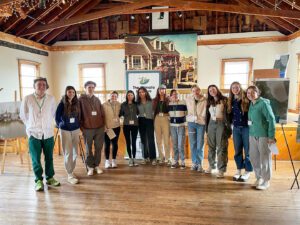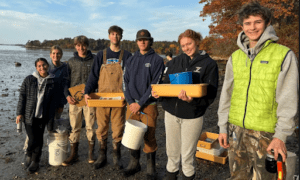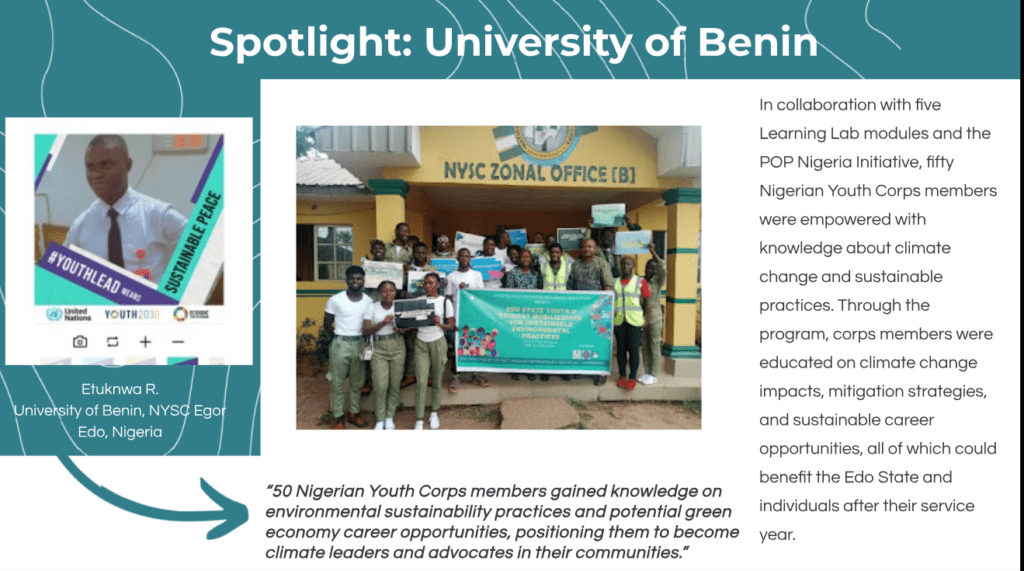Empowering Young People to Become Active Agents in building a more resilient future.
A conversation with Leia Lowery Executive Director, The Climate Initiative

Tell us about The Climate Initiative (TCI) and its impact
The Climate Initiative (TCI) is rebuilding the front porches of our communities to create connected, resilient communities through education, action, and collaboration. We work with educators and youth directly, and our programs create opportunities for intergenerational dialogue, place-based learning, and youth-led community projects that empower young people to become active agents in building a more resilient future.
Beyond addressing climate issues, our programs tackle the loneliness epidemic and climate anxiety many young people face today, by fostering a sense of belonging and purpose. Every program culminates in meaningful local action, bringing youth, local leaders, and community members together to co-create solutions from the ground up—fueling civic engagement and strengthening communities.
Our global Action Map showcases inspiring stories of youth implementing local solutions. They’ve advocated for solar power at schools, established community gardens that promote regenerative agriculture and feed the food insecure, led disaster preparedness workshops, and worked on restoring marshes and dunes. These projects build capacity for lasting change and resilience worldwide, all from a local community perspective.
Your work started because of a very specific place in Maine. Tell us about Kennebunkport.
The Climate Initiative began in Kennebunkport, Maine, a quintessential New England town with a working harbor, beautiful beaches, and an iconic lighthouse. It’s also a place on the front lines of climate change. The Gulf of Maine is warming faster than almost any other body of water its size, and New England is warming faster than any other region in the contiguous United States. Without action, much of this town could be underwater within a lifetime.
TCI was born when three impassioned educators decided to tackle Kennebunkport’s changing climate head-on. They created an award-winning, project-based curriculum that empowered high school and college students to take action by connecting a global issue to their own local landscape. This initiative grew from a partnership with the Kennebunkport Conservation Trust. The youth-led conversations with policymakers that followed created real action and change.
We believe everyone has their own “Kennebunkport” they want to protect. By sharing and replicating this model, we’re empowering young people across the country and beyond to lead the way in building a more resilient future.
TCI’s work is focused on project-based curriculum. What does this mean and share an example that exemplifies this model.

Project-based curriculum is an educational approach where students actively investigate and create solutions for real-world problems happening in their own backyard through studying their local landscape, and interviewing community members and leaders. Rather than just reading about climate change, students are empowered to find solutions or build public awareness of a local challenge, making the learning more meaningful and directly tied to action. This method fosters critical thinking, collaboration, and a sense of agency and at the same time builds community connection and resiliency.
Led by the Science Department, Ahfachkee School students are at the forefront of climate justice and equity. Using TCI’s learning tools, students from five science classes and the Student Government Association launched the “Ahfachkee Clothing Recycling Drive” to connect with neighboring communities in Big Cypress and Immokalee. This initiative was about more than collecting clothes; it empowered students to understand how their relationship with the fashion industry impacts local temperatures, threatens the migrant agricultural economy, and disproportionately affects vulnerable communities. Inspired by the Seminole message of reducing consumption, students collected 20 large trash bags of clothing, which were donated to the Immokalee Friendship House, providing essential support to those in need. This project is a testament to how students are transitioning from awareness to action, embodying their civic duty and becoming a powerful force for a more sustainable future within their community.
Tell us about the Climate Action Leadership Program. Who is this program for and how do you recruit and select participants?
The Climate Action Leadership Program (CALP) is a four-session program that empowers young people to take meaningful climate action. CALP is designed in a way that does not push a specific type of action onto participants. Instead, it guides them through the process of self-determining a local climate action that is accessible and achievable. It helps students learn what is happening in their community, learn how to communicate effectively, project manage, and find collaborations to create meaningful action.
We advertise our program on our website and through social media. Many young people are self-selecting to participate in this program; others are led by non-formal educators or environmental groups that choose to run the program with youth in their area. This fall, we have 89 young people from around the world who have opted to take this virtual class with us. This high interest demonstrates the strong desire among youth to find concrete ways to address climate anxiety and actively build the future they want to live in.
You have a number of Learning Labs for educators to use in their classroom. How do you decide on the topics to create learning labs for?
Learning Labs are developed based on a mix of our foundational curriculum from the Gulf of Maine Field Studies class and direct feedback from our community. We’ve expanded our topics by responding to specific requests from educators and collaborating with our partners. This ensures that the topics we cover are not only relevant and meaningful to classrooms but also address real issues facing communities in the United States and around the world. Our collaborative approach allows us to create Learning Labs that are both impactful and directly responsive to the needs of the educators and students we serve.
What are you most excited about when thinking about The Climate Initiative’s work over the next few years?
Thinking about the next few years, I’m most excited about seeing how The Climate Initiative can help create more systemic change in education by working with preservice educators to create our future leaders and workforce through education and experiential learning. I am still amazed at our growth and impact in just 5 years. What began in one small Maine town is now active in every U.S. state and 44 countries, reaching more than 600,000 young people and 5,000 educators.
What truly excites me is the power of these grassroots solutions to tackle a global issue. We’re seeing young people not just learn about climate change but actively lead and build resilience in their own communities. This work is about more than just the environment; it’s about rebuilding the “front porches” of our communities by fostering intergenerational connections and empowering youth to take on leadership roles now and in the future.

